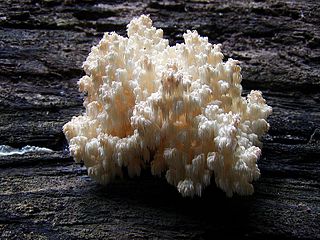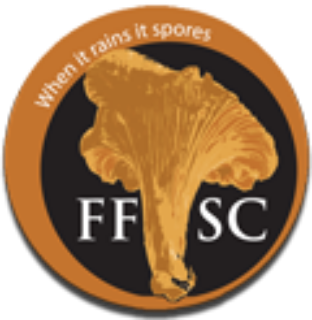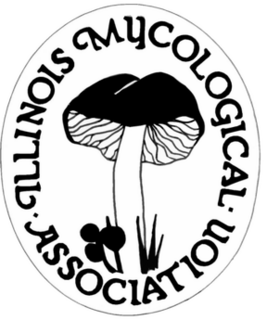
A mushroom or toadstool is the fleshy, spore-bearing fruiting body of a fungus, typically produced above ground, on soil, or on its food source.

Mycology is the branch of biology concerned with the study of fungi, including their genetic and biochemical properties, their taxonomy and their use to humans as a source for tinder, traditional medicine, food, and entheogens, as well as their dangers, such as toxicity or infection.

The fungal order Agaricales, also known as gilled mushrooms or euagarics, contains some of the most familiar types of mushrooms. The order has 33 extant families, 413 genera, and over 13,000 described species, along with six extinct genera known only from the fossil record. They range from the ubiquitous common mushroom to the deadly destroying angel and the hallucinogenic fly agaric to the bioluminescent jack-o-lantern mushroom.
The hymenium is the tissue layer on the hymenophore of a fungal fruiting body where the cells develop into basidia or asci, which produce spores. In some species all of the cells of the hymenium develop into basidia or asci, while in others some cells develop into sterile cells called cystidia (basidiomycetes) or paraphyses (ascomycetes). Cystidia are often important for microscopic identification. The subhymenium consists of the supportive hyphae from which the cells of the hymenium grow, beneath which is the hymenophoral trama, the hyphae that make up the mass of the hymenophore.

Pleurotus is a genus of gilled mushrooms which includes one of the most widely eaten mushrooms, P. ostreatus. Species of Pleurotus may be called oyster, abalone, or tree mushrooms, and are some of the most commonly cultivated edible mushrooms in the world. Pleurotus fungi have been used in mycoremediation of pollutants such as petroleum and polycyclic aromatic hydrocarbons. Oyster mushrooms contain Lovastatin, a form of cholesterol lowering statin.

The Fungi of Australia form an enormous and phenomenally diverse group, a huge range of freshwater, marine and terrestrial habitats with many ecological roles, for example as saprobes, parasites and mutualistic symbionts of algae, animals and plants, and as agents of biodeterioration. Where plants produce, and animals consume, the fungi recycle, and as such they ensure the sustainability of ecosystems.

In fungi, the sporocarp is a multicellular structure on which spore-producing structures, such as basidia or asci, are born. The fruitbody is part of the sexual phase of a fungal life cycle, while the rest of the life cycle is characterized by vegetative mycelial growth and asexual spore production.
The North American Mycological Association (NAMA), is a non-profit organization of amateurs and professionals who are interested in fungi, including mushrooms, morels, truffles, molds, and related organisms. NAMA aims "to promote, pursue, and advance the science of mycology."
Harry Delbert Thiers was an American mycologist who studied and named many fungi native to North America, particularly California. Thiers taught mycology at San Francisco State University. He comprehensively revised and expanded on the North American collection of boletes and named many new species.

A fungus is any member of the group of eukaryotic organisms that includes microorganisms such as yeasts and molds, as well as the more familiar mushrooms. These organisms are classified as a kingdom, which is separate from the other eukaryotic life kingdoms of plants and animals.

Hericium is a genus of edible mushrooms in the family Hericiaceae. Species in this genus are white and fleshy and grow on dead or dying wood; fruiting bodies resemble a mass of fragile icicle-like spines that are suspended from either a branched supporting framework or from a tough, unbranched cushion of tissue. This distinctive structure has earned Hericium species a variety of common names—monkey's head, lion's mane, and bear's head are examples. Taxonomically, this genus was previously placed within the order Aphyllophorales, but recent molecular studies now place it in the Russulales. Hericium means hedgehog in Latin.
Derek Agutter Reid was an English mycologist.
Daniel Elliot Stuntz was often called "Bud" by his family and colleagues. When Stuntz was young, his immediate and extended family moved from Ohio to Seattle. He had a sister named Alice Stuntz Marionneaux, whom he frequently visited in the later years. Stuntz's father, Chauncey Richards Stuntz, who worked in the sugarcane business, would be absent to work for most of the time. In 1920s, he was promoted as the general manager of a sugar mill, 'Jobabo' in Oriente Province in Cuba. During his father's absence, Stuntz' mother, Evelyn Elliot Stuntz, managed the family and arranged the children's summer vacations.

The Fungus Federation of Santa Cruz (FFSC) is a North American mycological club that evolved as a result of David Arora’s mushroom classes and early Fungus Fairs in the Santa Cruz, California area in the 1970’s.
Roy Watling, PhD., DSc, FRSE, F.I.Biol., C.Biol., FLS is a Scottish mycologist who has made significant contributions to the study of fungi both in identification of new species and correct taxonomic placement, as well as in fungal ecology.
The Société mycologique de France, often known by the abbreviation SMF, is an association linking French and French-speaking mycologists.
The following outline is provided as an overview of and topical guide to fungi:
Lois Hattery Tiffany (1924–2009) was a mycologist who taught for over 50 years at Iowa State University (ISU) and was known as "Iowa's mushroom lady". She won a number of awards, including becoming the first recipient of both the Mycological Society of America's Weston Award and the Iowa Governor’s Medal for Science Teaching. She published on many different aspects of fungal life, but her special area of research was Iowa's prairie fungi.
Yolande Dalpé is Research Scientist for Agriculture and Agri-Food Canada. She became the first mycologist in Ottawa to study the taxonomy of mycorrhizal fungi. Her research focuses on developing new information on taxonomy, phylogeny, distribution and biology of fungi, including systematic research related to biosecurity/alien invasive species as well as species involved in the development of bioproducts. She was awarded the Lawson Medal by the Canadian Botanical Association for her "cumulative, lifetime contributions to Canadian botany, for the research she has performed in mycology, and has been recognized nationally and internationally." The standard author abbreviation Dalpé is used to indicate this person as the author when citing a botanical name.

The Illinois Mycological Association or IMA is a group of mushroom enthusiasts, citizen scientists, foragers, and professional mycologists based in the Chicago area.









